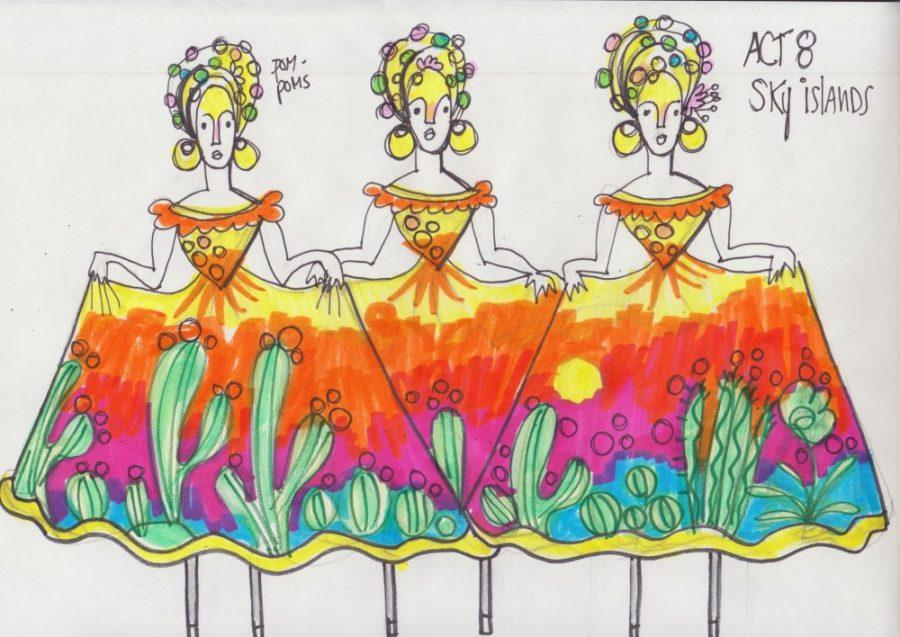This November, aerialists will tangle themselves in colorful silks above the crowd while dancers in vibrant folklorico dresses twirl on the ground to honor the dead in Tucson’s 30th annual All Souls Procession.
The All Souls Procession had its beginnings in Tucson in 1990, when local painter and sculptor Susan Johnson was grieving over the passing of her father, according to the All Souls Procession website.
Due to the timing and the picturesque and inherently Tucsonan aesthetic, the All Souls Procession is often confused with Día de los Muertos, a holiday widely celebrated in Latin American countries on Nov. 1. However, the All Souls Procession takes its roots from the local art community. According to the All Souls Procession website, the only connections the All Souls Procession has to Día de los Muertos is the timing and the people.
The procession takes place at a time in the year when many different cultures around the world believe that the separation between the living and the dead is thinnest, according to the All Souls Procession website.
“It is a time to celebrate our ancestors,” said Denise Bey, the assistant dance director for the All Souls Procession finale.
As the procession has grown over the years, more people have brought their own beliefs and traditions to the celebration. It now brings 100,000 participants from all over the world, according to Eva Peña, the social media director and Urn attendant for the All Souls Procession.
“We have people who just stand on the sidewalks and watch, and then we have people [walking] from the very beginning part of the procession, and then we have people that just gather at the finale site and wait for everything to get there,” Peña said.
Attendants dress up in elaborate outfits with large flower crowns and intricate face paint made to resemble calaveras, or skulls, to honor the people they are walking for.
People are welcome to use their own ideas or traditions to express and honor those ones they loved, according to Peña.
“It is a good idea for people to be creative and think outside the box,” Peña said.
The procession is a safe place where the Tucson community can come together, celebrate and talk about death in a healthy and comfortable way, according to Peña.
One major feature of the procession — which people take very seriously — is the Urn.
People participating in the procession can write letters, bring flowers or anything flammable that they wish to put in the Urn, according to Peña.
“They’ll write full letters and put them in an envelope and put a name on it and seal it,” Peña said. “Sometimes people will roll up the paper and decorate it with flowers and ribbon.”
The Urn is rolled alongside the people walking in the procession, and then, after everyone has completed the route, comes the big finale, showcasing aerialists, dancers and the burning of the Urn into the sky.
RELATED: Students organize event to celebrate Indigenous Peoples’ Day
Monica Silva, one of the aerialist directors for the finale performance at the All Souls Procession, first experienced the procession when she came to Tucson in 2007.
“I remember seeing an aerialist up on balloons way high in the sky and I thought it was amazing,” Silva said. “My friends and I thought, ‘We want to do that one day,’ and the next year we were a part of it.”
The All Souls Procession holds a special place in Silva’s heart. During one of the years that she was performing in the finale, she wasn’t just performing for herself or the audience, but for her father who had just passed away.
“I know for me the first year that I was up in the air, my dad had just died that year. So that was an example of whenever I’m performing, I’m also performing for everybody, but I’m also performing for myself, the people that I’m trying to honor,” Silva said.
The theme of the procession this year is “Realm of the Unseen,” inspired by Steve Roach, this year’s musical director. The theme is pulling from his immersive and evocative soundscapes, according to the All Souls Procession website.
“For me, that’s really a very exciting and interesting concept, so, like, whether it’s all the bacteria that make us up or maybe all the humans that make up a community or a world, all the certain multiplicities that make up a unit,” Silva said. “We are kind of a super organism like ants or bees, where there’s individuals but they act more like a colony.”
The All Souls Procession is a celebration for everybody. The aerialists will be up in the air and the dancers will be performing on the ground, embodying the meaning of the procession into one final performance, while the letters and things offered to the people who have passed burn in the Urn.
“I feel like seeing a ritual, seeing a spectacle, helps everyone release their emotions. Everyone’s prayers are going up, burning up into the sky,” Silva said. “There’s dancers on the ground and then there’s also us [aerialists] starting to bring the focus up off the Earth into the sky where ultimately the Urn will be up there burning, and I feel like we’re kind of a bridge between those two things.”
The All Souls Procession is a free event open to the public. The All Souls Procession and Finale Ceremony will take place on Nov. 3. The procession starts at 4 p.m. on Grande Avenue and ends at Mercado San Agustin.
For more information on the procession and associated events, visit https://allsoulsprocession.org.















